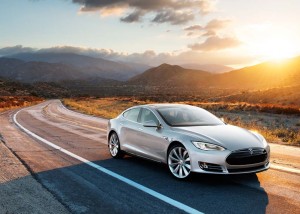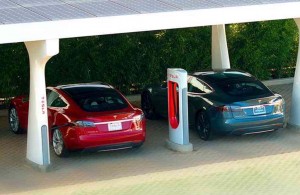Battery-car start-up Tesla Motors hopes to put a quick-charging “supercharger” within the reach of all U.S. motorists – and most of those in Canada – over the next several years, something that could eliminate the so-called “range anxiety” that has so far been a factor in the limited sales of plug-based” vehicles like Tesla’s Model S.
The roll-out of the Tesla Supercharger network will now come twice as fast as originally planned, with about twice as many of them being put in place, according to the maker’s founder and CEO Elon Musk. The fast-charging system will also be upgraded to reduce charging times by nearly half compared to the first chargers now in place, said Musk.
“It does mean quite a lot to mainstream customers, being able to drive you (battery) car wherever you want to go…at a moment’s notice,” said the South African-born executive. “So (this is) very important to accessing a broader audience” for battery-electric vehicles like the Tesla Model-S sedan that went on sales last summer.

All Model S battery-cars can use the Tesla Superchargers, though the feature is an option with the lower-priced versions of the car.
There are already a small number of Tesla Superchargers in operation, mostly along the West Coast – with some of the busiest of the fast-chargers located between San Francisco and California. There are also a small number along the East Coast serving travelers in the busy corridor between Washington, D.C. and Boston.
Tesla says it plans to triple their number by the end of June, with still more due to be operating by the beginning of autumn. And within six months, said a Tesla statement, “most of the major metro areas in the U.S. and Canada” will be within range of the growing network. That would allow a traveler to make it from Los Angeles to New York City using just Tesla Superchargers before the end of 2013.
(Tesla will use new stock offering to pay off DoE loans. Click Herefor the story.)
Eventually, Musk added during a media conference call, there will be “several 100” Superchargers covering not only major highways but also “parallel…scenic routes.” That would give a tourist exploring the coast of California, he noted, the opportunity to either race the length of the state on busy I-5 or take a more leisurely trip along the US-101 or CA-1 coastal routes.
Tesla is by no means the only company expanding the availability of the fast-charge systems many proponents see as critical to increasing demand for plug-in vehicles. Texas-based eVgo is setting up a number of its fast-charge stations in California, Texas and along the East Coast.
(New Chevy Spark EV will cost less than $20,000 after federal credits. Click Herefor the story.)
One difference is that a Tesla Model S owner who has purchased an optional Supercharger package (standard on the maker’s most-expensive model) will be able to plug in for free as often as desired. On a cross-country trip, noted Tesla officials, the savings could amount to hundreds of dollars compared to a gas-powered vehicle.
Slow charging times – and the limited availability of public stations – has been seen as one of the biggest drawbacks facing the nascent battery-car industry. Depending on the type of charger, a Model S could be recharged on a home or conventional system in anywhere from three hours to nearly a day. Depending on the version of the sedan, the Supercharger can provide as much as three hours of driving range in as little as 20 minutes, Musk promised.
That’s a significant improvement over the first Superchargers. They will be reprogrammed while Tesla ups their power from 90 to 120 kilowatts. The systems provide direct DC current while conventional chargers use lower power and AC current.
(Henrik Fisker wants to buy back floundering battery-car company Fisker Motors. Click Herefor more.)
There have been concerns that using so-called Level III charging might reduce the life of a battery pack. Musk insisted using the supercharger “every day…doesn’t affect the life of the fact.” The maker also moved to reduce anxieties about battery life earlier this year by announcing a new “no-fault” battery pack warranty.
To put an even greener spin on the announcement, Musk revealed that Tesla hopes to place solar chargers at as many of the Supercharger stations as possible. In fact, since most owners are expected to charge up over the weekend, Tesla believes that the power generated by the chargers will “add up to more energy than the cars consume,” with some of the solar-generated current thus being pumped back into the regional electric grid.
Ultimately there should be about one Tesla supercharger within reach of Model-S owners every 80 to 100 miles, Musk revealed. Most are likely to be located between, rather than in, urban centers – where conventional chargers are more common.
Some of the first Supercharger stations experienced so much demand that Model S owners had to wait in line. Tesla is looking to have more bays available going forward, a minimum of four places to plug in at each facility, more where demand is higher.
For his part, CEO Musk said he intends to soon repeat “a road trip I took in college,” this time taking his family from Silicon Valley to New York relying on the expanded Supercharger network.
Each new Supercharger station is expected to cost around $150,000 the executive noted, the price roughly doubling where solar power is used. Tesla’s latest stock offering – expected to raise about $1.1 billion – will help fund the bill. The maker also is using the fresh capital infusion to pay off its U.S. Energy Department loan.
(Desperate for sales, EV makers slash prices. Click Here.)
While the expanded availability of quick chargers should improve the appeal of battery power, observers say, they also caution that the hefty price premium for battery power remains a drawback. Manufacturers appear to be working on that issue, as well, however. Honda, for example, is cutting by nearly a third the lease price for its new Fit EV, and a price cut for the Nissan Leaf, earlier this year generated a surge in sales.
Nonetheless, plug-based vehicles still account for barely 0.5% of the total U.S. new vehicle market.
Tesla’s Supercharger expansion is the latest in a series of announcements in recent weeks. The maker expects to detail a similar program for Europe soon, as well. Meanwhile, Musk hinted that there will be another major announcement from the Silicon Valley-based maker on June 20th.


Unless these super charging stations are almost as prevalent as petrol stations, EVs are still only practical for city use. How many people are going to drive 20-30 miles out of their way and then wait to “recharge” their battery? Sure some tree huggers might be willing but the majority of people buying an EV would be selling it fast before they’d endure this inconvenience.